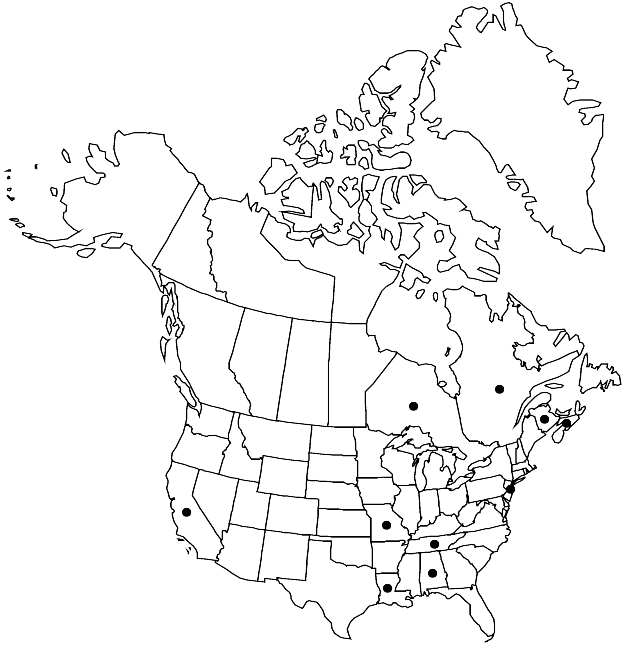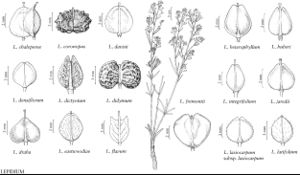Difference between revisions of "Lepidium coronopus"
Novon 14: 156. 2004.
FNA>Volume Importer |
FNA>Volume Importer |
||
| Line 14: | Line 14: | ||
|name=Carara coronopus | |name=Carara coronopus | ||
|authority=(Linnaeus) Medikus | |authority=(Linnaeus) Medikus | ||
| − | }}{{Treatment/ID/Synonym | + | }} {{Treatment/ID/Synonym |
|name=Coronopus procumbens | |name=Coronopus procumbens | ||
|authority=Gilibert | |authority=Gilibert | ||
| − | }}{{Treatment/ID/Synonym | + | }} {{Treatment/ID/Synonym |
|name=Coronopus ruellii | |name=Coronopus ruellii | ||
|authority=Allioni | |authority=Allioni | ||
| − | }}{{Treatment/ID/Synonym | + | }} {{Treatment/ID/Synonym |
|name=Coronopus squamatus | |name=Coronopus squamatus | ||
|authority=(Forsskål) Ascherson | |authority=(Forsskål) Ascherson | ||
| − | }}{{Treatment/ID/Synonym | + | }} {{Treatment/ID/Synonym |
|name=Coronopus verrucarius | |name=Coronopus verrucarius | ||
|authority=(Garsault) Muschler & Thellung | |authority=(Garsault) Muschler & Thellung | ||
| − | }}{{Treatment/ID/Synonym | + | }} {{Treatment/ID/Synonym |
|name=Lepidium squamatum | |name=Lepidium squamatum | ||
|authority=Forsskål | |authority=Forsskål | ||
| − | }}{{Treatment/ID/Synonym | + | }} {{Treatment/ID/Synonym |
|name=Senebiera coronopus | |name=Senebiera coronopus | ||
|authority=(Linnaeus) Poiret | |authority=(Linnaeus) Poiret | ||
| Line 69: | Line 69: | ||
|publication year=2004 | |publication year=2004 | ||
|special status= | |special status= | ||
| − | |source xml=https://jpend@bitbucket.org/aafc-mbb/fna-data-curation.git/src/ | + | |source xml=https://jpend@bitbucket.org/aafc-mbb/fna-data-curation.git/src/8f726806613d60c220dc4493de13607dd3150896/coarse_grained_fna_xml/V7/V7_930.xml |
|tribe=Brassicaceae tribe Lepidieae | |tribe=Brassicaceae tribe Lepidieae | ||
|genus=Lepidium | |genus=Lepidium | ||
Revision as of 18:00, 18 September 2019
Annuals; glabrous or puberulent. Stems often several from base, usually procumbent to decumbent, rarely ascending, branched distally, (0.3–)0.6–2.5(–3.5) dm. Basal leaves rosulate; petiole (1–)2–5(–5.8) cm; blade 1- or 2-pinnatisect, (3–)4–10(–15) cm, margins (of lobes) entire or dentate. Cauline leaves shortly petiolate; blade pinnatisect, base cuneate, not auriculate, margins (of lobes) entire or dentate, (similar to basal, smaller and less divided distally). Racemes (leaf-opposed), ± slightly elongated in fruit; rachis glabrous. Fruiting pedicels ascending, straight, (stout, terete), (0.7–)1–2(–2.4) × 0.4–0.5 mm, glabrous. Flowers: sepals (persistent), oblong, 1–1.5 × 0.5–0.6 mm; petals white, obovate to obovate-oblong, 1–2 × 0.4–0.6 mm, claw absent; stamens 6; filaments (median pairs) 0.7–1 mm, (glabrous); anthers 0.15–0.25 mm. Fruits (indehiscent), reniform to ovate-cordate, 2.3–3.4 × 3–4.4 mm, apically not winged, apical notch absent; valves thick, rugose-verrucose, with distinct ridges, prominently veined, glabrous; style 0.2–0.7 mm. Seeds ovate-oblong, (curved, not winged), 1.2–1.6 × 0.7–1 mm. 2n = 32.
Phenology: Flowering May–Aug.
Habitat: Waste grounds, abandoned fields, pastures, roadsides, disturbed sites
Distribution

N.B., N.S., Ont., Que., Ala., Calif., La., Mo., N.J., Tenn., Europe, sw Asia, n Africa, introduced also in South America (Chile), s Africa, Australia.
Discussion
Selected References
None.
